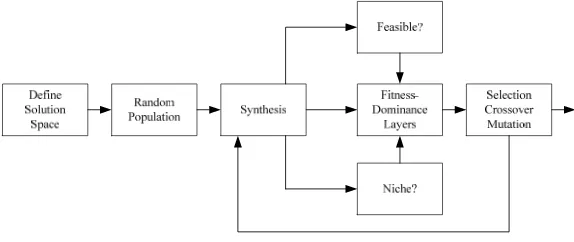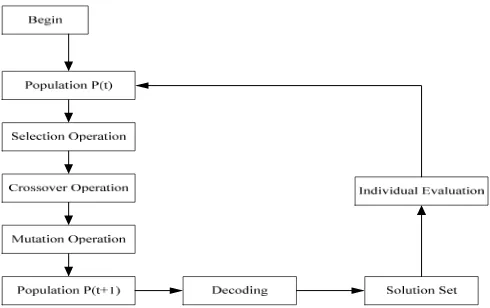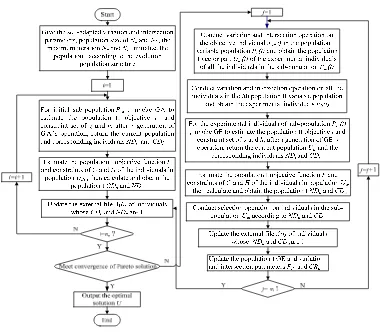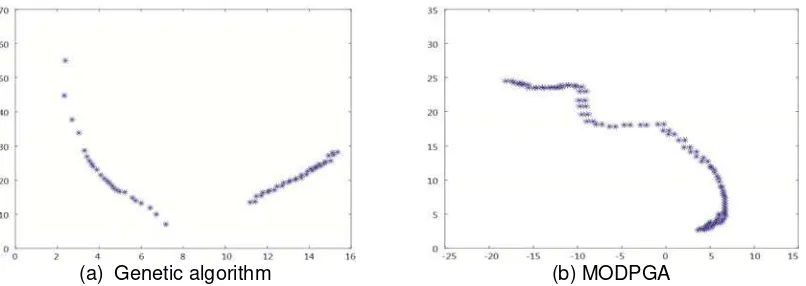DOI: 10.12928/TELKOMNIKA.v14i1.2740 238
Application of A Self-adaption Dual Population Genetic
Algorithm in Multi-objective Optimization Problems
Cheng Zhang*, Hao Peng
School of Information, Hunan International Economics University, Changsha 410205, Hunan, China *Corresponding author, email: [email protected]
Abstract
Multi-objective evolutionary algorithm is a powerful tool in resolving multi-objective optimization problems. This algorithm inherits the advantages of parallel random search, strong global searching capability and the ability to solve highly-complicated non-linear problems of evolutionary algorithm and it is usually used in the optimization problems with multiple mutual conflicts. However, such algorithms are slow in convergence and easy to be trapped in local optimal solution. This paper proposes a objective dual population genetic algorithm (MODPGA) and explores the improvement strategies of multi-objective genetic algorithm. The adoption of self-adaption and dual population strategy can guarantee that the algorithm of this paper can converge to Pareto solution set in a reliable and quick manner and it can perform more extensive search on the objective function space and conduct more samples on multi-objective functions so as to be closer to the approximate optimal solution set of global optimal solutions. This solution set also includes more optimal feasible points and provides reliable basis for the decision making.
Keywords: multi-objective optimization, genetic algorithm, adaptive dual population
Copyright © 2016 Universitas Ahmad Dahlan. All rights reserved.
1. Introduction
Multi-objective optimization is an NP difficult problem which widely exists in reality and the optimization of the overall objective is realized by weighing the optimization of multiple objectives under one overall objective, therefore, it becomes very difficult to take the weights of every sub-objective into consideration and require high latitude and large scale [1]. Worse still, the traditional optimization means are even more stringent on the form of the objective function. Generally, the problems usually have more than one solution and the results of every solution are incomparable. So far, the multi-objective optimization theory not only makes important achievements including the formation and improvement of a set of optimization theory which parallels to the single-objective optimization, but it has also been applied more and more extensively [2].
At present, multi-objective optimization problem has been applied more and more widely, involving many fields. In daily life and projects, optimization is not only required in one index but it demands several indexes to achieve the optimization at the same time. A great number of problems can be reduced as the multi-objective optimization problem to make multiple objectives to realize optimization under certain constraint conditions [6]. The mathematical description of multi-objective optimization problem is made of decision variable, objective function and constraint condition. Because of the differences of the application fields of multi-objective optimization problem, the corresponding mathematical description is different, including general multi-objective optimization, dynamic multi-objective optimization, certain multi-objective optimization and uncertain multi-objective optimization. The multi-objective optimization problem can be described as follows mathematically:
Min(&Max) y f x( )[ ( ),f x1 f x2( ),...,f xn( )](n1, 2,...,N) inequality constraints, h x( ) is M equality constraints, the constraints constitute the feasible
region and
x
d_ min andx
d_ max are the upper and lower bounds of vector search. The above equation is the multi-objective optimization problem which including the minimization problem (min), the maximization problem (max) and certain multi-objective optimization problem [7].The concept of the optimal solution or Pareto optimal solution to multi-objective optimization problem is as follows:
Definition 1: If any d which meets d
1,D and *Definition 2: Pareto optimal solution is the solution which can’t be dominated by any solution in the feasible solution set. If *
x is a point in the search space, *
x is the Pareto optimal solution when and only when no x (in the feasible region of the search space) can make
0
Definition 4: The set consisting of all Pareto optimal solutions is the Pareto optimal set of the multi-objective optimization problem and it can also be the acceptable or effective solution set.
Figure 1. Optimization process
3. Genetic Algorithm
The main characteristic of genetic algorithm is that the strategy of population search and the information exchange between the individuals in the population are not based on gradient information. It can be used to handle the complicated and non-linear problems which are difficult to be solved by traditional search methods in particular and it can also be widely applied in such fields as combinatorial optimization, machine learning, self-adaptive control, planning and design as well as artificial life. As a global optimization search algorithm, genetic algorithm is one of the core intelligent computation technologies in the 21st century for it is easy and universal to apply, it has strong robustness, it can be used in parallel processing and it has a wide application scope [8].
3.1. The Principles and Methods of Genetic Algorithm (1) Chromosome Encoding
Encoding refers to the transformation method to transfer the feasible solutions to one problem to the search space which genetic algorithm can handle.
De Jong once proposed two practical coding principles: one is to use the encoding plan which is related to the problem to be solved and which has lower-order, short-defined length pattern and the other is to utilize the encoding plan which can give natural presentation or description to the problem or which has the minimum coded character set [9].
Encoding methods include the following: binary encoding method, gray-code encoding method, floating-point number encoding method, parameter cascade encoding method and multi-parameter cross-over encoding method.
(2) Fitness Computation
Basically, there are three methods to transform the objective function value f x( ) of a certain point in the solution space to the fitness function value Fit f x( ( )) of the corresponding individual in the search space:
(a) Directly transform the objective function value f x( ) to be solved to the fitness
function value Fit f x( ( )) and make ( ( )) ( ) max .
( ) min
f x The objective function is imized Fit f x
f x The objective function is imize
(b) As for the minimization problem, perform the following transformation
max ( ) ( ) max (c) If the objective function is the minimization problem,
1
If the objective function is the maximization problem,
(1) Selection
Selection operation combines elite selection and roulette wheel selection. At first, it directly copies several elite individuals to the population in the next generation and select the rest individuals with roulette wheel method. In this way, it can not only preserve the excellent individuals in the population, but also protect the diversity of the individuals in the population.
(2) Crossover and Mutation
In the genetic operations, perform crossover and mutation operations at the crossover probability Pc and mutation probability Pm. After crossover and mutation operations, conduct validation test on the newly-generated individuals to check whether the solutions of the new individuals meet the sequence constraints. If so, it proves that these new individuals are effective; if not, they are invalid and adjustments needs to be made on them. Redistribute some operations to make them effective genes [11, 12].
The basic flowchart of genetic algorithm is indicated as Figure 2.
Figure 2. Basic flowchart of genetic algorithm
4. Design of Multi-objective Genetic Algorithm Based on Self-adaption and Dual Population Strategy
In the genetic evolution, the differences among the fitness of the individuals in the population vary from the differences of the evolution. At the early evolution, the difference is big, but it becomes small in the late evolution. In order to guarantee that the individuals can be selected in early evolution to preserve the diversity of the individuals in the population and highlight the excellent individuals in the late evolution to improve the competitiveness of the individuals, this paper has come up with a Multi-objective Dual Population Genetic Algorithm (MODPGA). The steps of MODPGA are as follows [13, 14]:
(1) When the variable part of the individual ( 1)
( 1,..., )
l
i n j
l l
X j n in the population I
( 1,..., )
ui u
P i n mutates, randomly select individuals to generate the variable part of the mutation vector from the variable population (the size is nu).
(2) When the variable part (i 1)nl j l
X of the individual ( 1)
( 1,..., )
l
i n j
l l
X j n in the population P iui( 1,...,nu) mutates, randomly select individuals to generate the variable part of
i u X
the mutation vector from the variable population II Pl (the size is nl) without being limited to the population I Pui.
(3) In order to protect the evolution structure of population I, MODPGA updates the population I Pui in a dynamic manner so as to realize the dynamic update of the entire population I.
(4) Preserve the non-dominant elite individuals with the level of and by using external archival strategy.
Figure 3. Flowchart of MODPGA
The process for MODPGA to conduct mutation and crossover operations to generate new experimental individuals includes two stages.
Stage I: Randomly select three different individuals from the existing objective individual in nu different variable populations to perform variable mutation and crossover operations of
population I and generate the variable part of the experimental individuals ( 1)
( 1,..., )
l
i n j
l l
U j n .
Stage II: As for the variable part (i 1)nl j l
X of all the individuals in population Pui, randomly select individuals to perform mutation and crossover operations from the entire population (the size is nu) and generate the variable part of the experimental individual
(i 1)nl j
U . The flowchart of MODPGA is indicated as Figure 3.
5. Performance Test and Analysis of the Algorithm in This Paper
Based on the the theoretical research and experimental verification, this paper proposes a new improved Multi-objective Dual Population Genetic Algorithm (MODPGA). In
1
u
ND NDl 1
u P
Constraints: 25 x x1, 225.
Figure 4 is the comparison of Pareto front-ends of Function 1 by basic genetic algorithm and MODPGA respectively.
(a) Genetic algorithm (b) MODPGA
Figure 4. Comparison of pareto front-ends by two algorithms (function 1)
(2) Function 2: Seek the minimums of two objective functions.
2
1 1 2 2 1
2
1
( ( 3) 2 ); ( 3 )
2
MIN f x x MIN f x
x
;
Constraints: 0x x1, 220.
In order to preserve the universality, this paper also chooses the fitness function to seek the minimum function and the Pareto front-ends of two algorithms are indicated in Figure 5.
(a) Genetic algorithm (b) MODPGA
Figure 5. Comparison of pareto front-ends by two algorithms (function 2)
approximate Pareto solution with better diversity. In one word, the optimization performance of MODPGA has been greatly improved compared with the traditional algorithms.
6. Conclusion
This paper explores the improvement strategy of multi-objective genetic algorithm and designs a highly-effective adaptive dual population genetic algorithm which can quickly converge to the real Pareto front-end shape. The MODPGA method proposed in this paper has lower time complexity, makes the selection strategy have higher selection pressure and guarantee that the population can converge to the real Pareto front-end part.
Acknowledgements
This work was supported by Higher Scientific Research Project Of Hunan Province(15C0779,14B104), Planned Science and Technology Project of Hunan Province of China(No.2014FJ3040).
References
[1] Karoon Suksonghong, Kittipong Boonlong, Kim-Leng Goh. Multi-objective Genetic Algorithms for Solving Portfolio Optimization Problems in the Electricity Market. International Journal of Electrical Power & Energy Systems. 2014; 58(24): 150-159.
[2] Ioannis K Karathanassis, Elias Papanicolaou, Vassilios Belessiotis, Georgios C Bergeles. Multi-objective Design Optimization of a Micro Heat Sink for Concentrating Photovoltaic/Thermal (CPVT) Systems using a Genetic Algorithm. Applied Thermal Engineering. 2013; 59(1): 733-744.
[3] Rahul Dhabale, Vijay Kumar S Jatti, TP Singh. Multi-objective Optimization of Turning Process During
Machining of AlMg1SiCu using Non-dominated Sorted Genetic Algorithm. Procedia Materials Science.
2014; 6(1): 961-966.
[4] Chyi-Tsong Chen, Hung-I Chen. Multi-objective Optimization Design of Plate-Fin Heat Sinks using a Direction-based Genetic Algorithm. Journal of the Taiwan Institute of Chemical Engineers. 2013; 44(2): 257-265.
[5] Laxminarayan Sahoo, Asoke Kumar Bhunia, Parmad Kumar Kapur. Genetic Algorithm Based Multi-Objective Reliability Optimization in Interval Environment. Computers & Industrial Engineering. 2012; 62(1): 152-160.
[6] S Pourzeynali, S Salimi, H Eimani Kalesar. Robust Multi-objective Optimization Design of TMD Control Device to Reduce Tall Building Responses Against Earthquake Excitations using Genetic Algorithms. Scientia Iranica. 2013; 20(2): 207-221.
[7] D Gossard, B Lartigue, F Thellier. Multi-objective Optimization of a Building Envelope for Thermal Performance using Genetic Algorithms and Artificial Neural Network. Energy and Buildings. 2013; 67(12): 253-260.
[8] Amani Bensghaier, Lotfi Romdhane, Fethi Benouezdou. Multi-objective Optimization to Predict Muscle Tensions in a Pinch Function using Genetic Algorithm. Comptes Rendus Mécanique. 2012; 340(3): 139-155.
[9] Reza Soleimani, Navid Alavi Shoushtari, Behrooz Mirza, Abdolhamid Salahi. Experimental Investigation, Modeling and Optimization of Membrane Separation using Artificial Neural Network and Multi-objective Optimization using Genetic Algorithm. Chemical Engineering Research and Design. 2013; 91(5): 883-903.
[10] Sachindra K Rout, Balaji K Choudhury, Ranjit K Sahoo, Sunil K Sarangi. Multi-objective Parametric Optimization of Inertance Type Pulse Tube Refrigerator using Response Surface Methodology and Non-dominated Sorting Genetic Algorithm. Cryogenics. 2014; 62(7): 71-83.
[11] Rung-Chuan Lin, Mustafa Y Sir, Kalyan S Pasupathy. Multi-objective Simulation Optimization using Data Envelopment Analysis and Genetic Algorithm: Specific Application to Determining Optimal Resource Levels in Surgical Services. Omega. 2013; 41(5): 881-892.
[12] ászló Daróczy, Gábor Janiga, Dominique Thévenin. Systematic Analysis of the Heat Exchanger Arrangement Problem using Multi-objective Genetic Optimization. Energy. 2014; 65(1): 364-373. [13] Jafar Ramadhan Mohammed. Comparative Performance Investigations of Stochastic and Genetic
Algorithms under Fast Dynamically Changing Environment in Smart Antennas. International Journal of Electrical and Computer Engineering. 2012; 2(1): 98-105.
[14] Amit Kumar Yadav, OP Rahi, Hasmat Malik, Abdul Azeem. Design Optimization of High Frequency Power Transformer by Genetic Algorithm and Simulated Annealing. International Journal of Electrical



